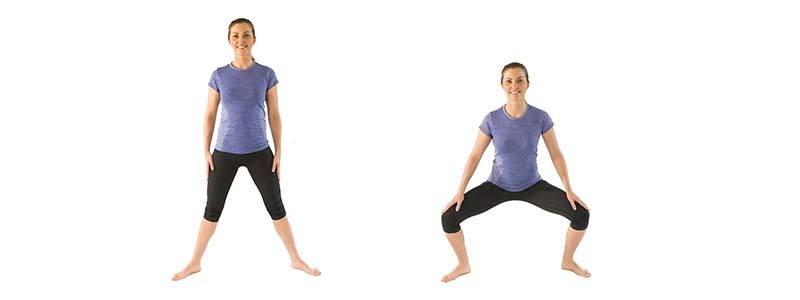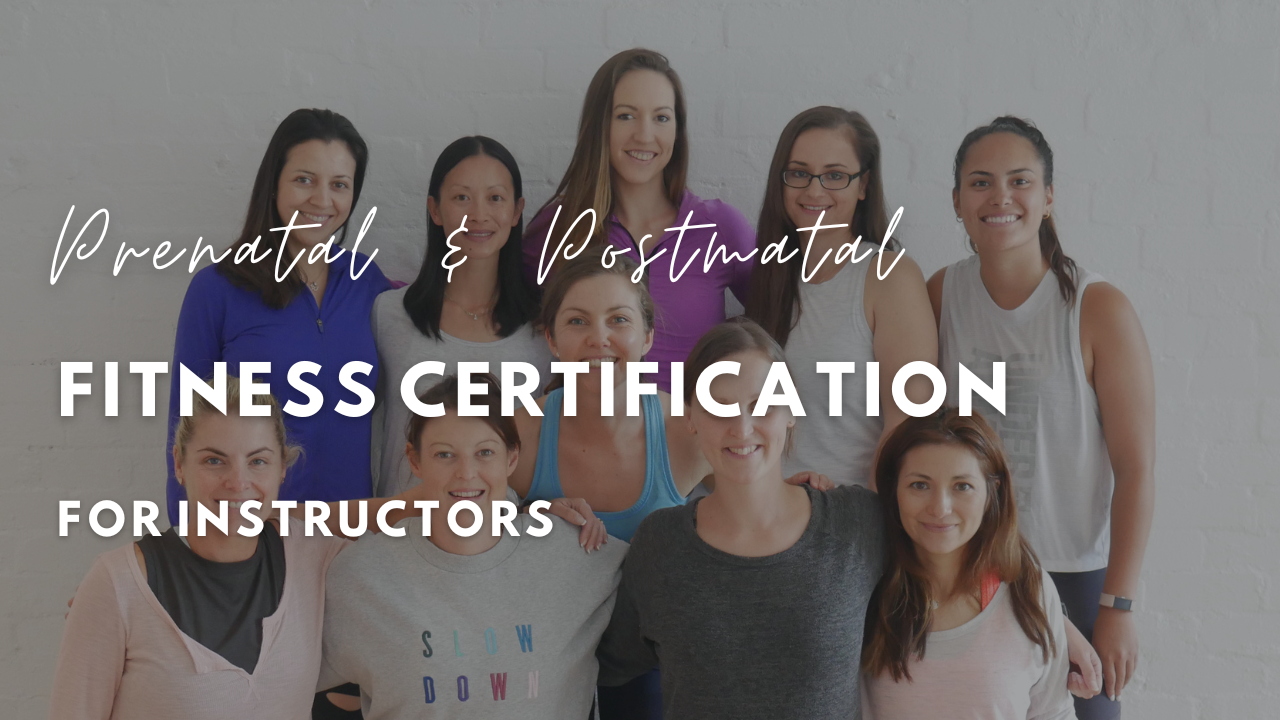Can I Do Squats while Pregnant?
Can I Do Squats while Pregnant?
Can I do squats when pregnant is a question I get asked all the time. and the answer is; Yes, you can and they are good for you.
BUT only if you do them right. As with all exercise during pregnancy, please get your doctor's approval first.
I have included five of the best squatting during prenatal exercises below. Many of these are also included in my online workout videos. Also, I want you to watch this video below.
You will learn how to perform squats with the right technique to keep both you and baby safe.
Is it Safe to Squat while Pregnant?
Yes, absolutely. They are one of my favorite exercises as they help to strengthen your core and your legs. But here is what you must know. When you have a strong core you will experience a more empowering pregnancy and childbirth.
In pregnancy, squats are a great way to maintain strength and range of motion in the core, hips, glutes, and pelvic floor muscles.
When performed correctly, squats can help improve posture, and they will assist you during labor.
Squatting Technique is Important
When you learn how to squat correctly it will help you throughout your pregnancy and also postpartum recovery.
When you weren't pregnant you may have performed squats in the gym using weights.
As a fitness trainer I can say that squats are an ideal compound exercise. Squats work so many different body parts.
Now you're pregnant, you can definitely benefit from squatting as long as you take appropriate precautions as I have outlined in this post and also my training video.
Benefits of Squats
Squats are a fantastic exercise for expecting mothers as they help to strengthen the pelvic floor, glutes, and leg muscles, which are all crucial for childbearing and delivery.
Furthermore, squats can improve circulation and decrease discomfort by encouraging more efficient blood flow throughout the body.
Consistent squatting may also help to prepare the body for labor by enhancing endurance and flexibility in the pelvic area.
It's important for pregnant women to recognize these benefits and understand how squats can be integrated into their fitness routines safely.
Improved Posture
In addition to physical benefits, squatting can also contribute to better posture and balance, which may become compromised as the baby grows and the center of gravity shifts.
By reinforcing core stability and leg strength, squats can help to counteract the strain on the lower back often experienced during pregnancy.
Moreover, engaging in regular exercise such as squatting can boost mood and energy levels, which is valuable during pregnancy when fatigue and emotional changes are common.
1. Strengthen your legs
Having strong legs is important for all stages of your life.
They are your foundation. Having strong legs when pregnant are important to help carry the additional weight you put on. Strong legs also assist you with various birthing positions.
2. Strengthen your glutes
Strong glutes provide you with similar benefits to having strong legs. These muscles also help to prevent lower back injuries.
3. Improve lower body mobility
Being more mobile is an advantage in many ways. From moving when pregnant, to being able to move better when you are carrying or picking up your newborn baby.
4. Keep bones and joints healthy
Strength training leads to stronger bones. This is very important to you especially for later on in life. This applies to most weight-bearing activities.
5. Prepare for labor and delivery
When you participate in your antenatal classes you will soon discover that some of the birthing positions being taught to you require strength in your legs.
If you are physically prepared for childbirth then your experience will be a more positive one.
I am constantly hearing from our members how one of the greatest benefits of my program comes when they need it most - during labor!
What Happens when You Squat Incorrectly?
1. You do not activate the right muscles.
2. Additional stress is placed on ligaments and joints.
3. You are at increased risk of injury.
4. Your center of gravity changes, so you are greater risk of falling.
5. You may experience pelvic pain.
My Goal is to Help YOU!
My goal with this post is to ensure that you, and all pregnant women, are safely performing various squats. Squats are not a high impact activity, but there can be other risks if performed incorrectly.
Your pelvic floor muscles can be directly impacted so let's ensure you are doing them the right way!
What is a Squat?
The Squat is a popular exercises performed by gym goers with all sorts of goals. It is essentially a lower body exercise. It will get your heart rate going so make sure you don't push too hard.
If you search the internet, you will find numerous videos and squat variations. Some use a barbell. Some used a dumbbells. And some use body-weight.
Squat Variations - Shallow squats
Shallow squats are better because the deeper the squat, the greater the chance that muscles which are too tight will change the motion.
As a result, the external rotators and hamstring muscles instead of the gluteal muscles will get involved, which are the muscles you want to be working in this type of exercise.
Here's a Progression:
Perform shallow squats on a foam pad. This movement creates an unstable surface and co-contraction of muscles, and is a safe and effective way to strengthen the gluteus muscles, thighs, and hips.
The key is to avoid pelvic pain and you can do this by using the correct technique.
Muscles Used when Squatting
The squat exercise mainly targets your quadriceps, hamstrings and the glutes.
A squat is a strength exercise where you lower your hips from a standing position and then stands back up. During the descent of a squat, your hip and knee joints flex while your ankle joint dorsi-flexes.
Conversely the hip and knee joints extend and the ankle joint plantar-flexes when standing up.
Squats are considered a vital exercise for increasing the strength of the lower body muscles as well as developing core strength.
The primary agonist muscles used during the squat are the:
1. Quadriceps femoris
3. Gluteus maximus
The squat also isometrically uses the erector spinae and the abdominal muscles, among others.

What are Squat Pulses?
Squat pulses help to strengthen your glutes, hamstrings and deep core.
Having a strong deep core will help to improve your balance and posture when pregnant. This stronger core will help improve your quality of life in the way that you hold yourself and carry your baby.
Benefit of Squat Pules?
One of the main benefits of pulsing is that you are constantly engaging the leg and your core muscles. As a result, this also allows for you to hold a squat longer as you are not releasing and re-engaging that connection.
Performing effective and safe exercises, like the squat, during pregnancy and postpartum is essential to functional movement in your daily life.
What Do Squat Pulses Work?
Squat Pulses are great for keeping your legs strong and for the strengthening of your deep core as well. Also, you need variety in your workouts to maintain motivation.
So adding a squat variation to your prenatal exercise routine can help with the prevention of and reduction of existing pregnancy lower back pain.
How to Do Squat Pulses
1. Begin by standing in a wide squat position.
2. Keep your feet and knees aligned with your hips.
3. Rise up just part way.
4. Find the spot where you feel the underside of your legs doing most of the work.
5. Now exhale doing small, controlled squat pulses.
6. Make sure you move only through a small range of motion.
7. Do this exercise in sets of 10 to 20 reps.
What is a Pulse Lunge?
A body-weight pulse lunge is an exercise that targets the quads and to a lesser degree also targets the calves, glutes, groin and hamstrings.
Learning proper body-weight lunge pulse form is easy with the step by step body-weight lunge pulse instructions below.
Step 1:
From a standing start, step forward like a regular lunge.
Step 2:
Then, lunge down partially, about a quarter of the way down as you would for a normal lunge. This is the starting position.
Step 3:
Now you will 'pulse' up and down, performing the lunge by going up and down (approx 3-5 inches).
Step 4:
Always stay in the lunge position and never stand up during the exercise.
Step 5:
Complete for the desired number of repetitions. Start with sets of 10 and then progress.
Common Mistakes to Avoid
1. Starting from the knees.
In this position you are already starting with your muscles contracted. What you want to do is perform a squat through its full range of motion.
2. Trying to lift too much weight.
Normally, when you are trying to add muscle, the best way is to progressively increase the weight you lift. This results in greater strength and bigger muscles.
But remember, your goals have changed. Lifting too much weight causes you to strain and will lead to an injury.
3. Bending your back.
You should always perform an exercise by keeping your spine in line. When you bend your back, it can take the load and this leads to injury.
4. Lifting your heels off the floor.
For one, you need your feet planted on the ground to help you keep your balance and avoid falling.
Secondly, lifting your heels involves your calf muscles and actually takes away from the major muscle groups you are trying to strengthen.
5. Letting your knees go inward
Keep your knees in line. Don't let them go inward, or flare outwards.
6. Not warming up
You should always perform a few warm-ups sets. Over the years we have progressed from the old static stretches to more dynamic warm-ups.
7. Pelvic Pains when Squatting
If you experience pelvic pain then stop and chat to your doctor.
Anatomy of a Great Squat
A squat is a strength exercise in which you lower your hips from a standing position and then immediately stand back-up.
As you go down, the hip and knee joints flex while the ankle joint dorsi-flexes. When you stand-up, the hip and knee joints extend and the ankle joint plantar-flexes.
Modify Squats for Each Trimester
During the first trimester, most women can continue with a standard squat routine with minimal modifications.
However, as the pregnancy progresses, it's important to adjust the exercise to accommodate the growing belly and shifting center of gravity.
In the second trimester, women may want to widen their stance to maintain balance and consider using a chair or ball for support.
Third Trimester
By the third trimester, maintaining balance becomes even more crucial, so squats against a wall or using a stability ball can be beneficial.
It's also essential to listen to the body and reduce the depth of the squat if there is any discomfort.
As the pregnancy progresses, some women might experience pelvic or back pain, which may require further modifications or the inclusion of supportive equipment such as resistance bands or Pilates rings.
It's always best to consult with a fitness professional who specializes in prenatal exercise to tailor a squatting routine that is safe and effective for the specific needs of each trimester.
How Do You Do Squats when Pregnant?
1. First Trimester Pregnancy Squats
Before your belly is getting in the way, you can start by spreading your feet hip width apart. Reach your hips back as if you were sitting in a chair until your hips are almost parallel with the ground.
Stand up returning to the start position and repeat.
2. Second Trimester Pregnancy Squats
I want you to start by squatting down until hips are almost parallel with the ground.
Hold at the bottom as you pulse a few inches up and down twice. Now. stand up to your toes and then return to squat position and repeat.
3. Third Trimester Pregnancy Squats
Stand with your head and back against a wall. Lower your body into a squat position until your thighs are parallel to the floor. Hold for 30 seconds.
Pregnancy Safe Squats
1. Chair squats while Pregnant
If you struggle with balance, try this one. Using a chair for support gives you the confidence to perform squats.
Here's How to Do it
1. Stand behind the chair.
2. Make sure the chair is stable and cannot move.
3. Hold onto the chair with feet wide apart as shown.
4. Squat down.
5. Stand back up using your gluteus muscles to initiate the movement.
Sets: 3 sets
Reps: 10 to 12 repetitions.

2. Body-weight squats
When pregnant, your body weight may offer enough resistance for you to work out effectively. If you wish to squat with more weight, then pick up a pair of dumbbells.
Instructions for body-weight squats
1. Stand with feet shoulder-width apart.
2. Hold your arms straight out in front of your body.
3. This will help with balance (only if you are not holding dumbbells)
4. Lower yourself into a squat position.
5. Squat down as far as you're comfortable while keeping your back straight.
6. Try to keep your weight in your heels.
7. Keep your knees behind or in line with your toes.
Return to starting position, squeezing your glutes on the way up.
Set: 3 sets
Reps: 10 to 12 repetitions.

Squats with Dumbbells

3. Squats against wall with exercise ball
Here's How to Do it
1. Stand against a wall with an exercise ball between the wall and your lower back.
2. Place feet shoulder-width apart.
3. Hold your arms straight out.
4. This will help with maintaining your balance.
5. Contract your abs. Pull in your belly-button.
6. Lower yourself into a sitting position.
7. Keeping your back straight and shoulders back.
8. Maintain a 90-degree angle at the knee when in a full squat.
9. Return to starting position, squeezing your glutes on the way up.
Sets: 3 sets
Reps: 10 to 12 repetitions.
4. Sumo squats
This squat variation targets the inner muscles of the thighs and glutes.
Instructions for Sumo squats
1. Start in a wide stance with your feet greater than shoulder-width apart.
2. You toes need to be pointing outward.
3. Your knees tracking in line with the toes.
4. Squat down into a squat position.
5. Keep your back straight.
6. Weight in your heels.
7. Keep your legs turned out throughout the movement.
8. Make sure your knees do not cave inwards.
9. Return to the starting position, squeezing your glutes on the way up.
Sets: 3 sets
Reps: 10 to 12 repetitions.
Safety note: Do not go past your normal range of motion.

5. Deep squat hold with pelvic floor contraction
Here's How to Do it
1. Keep your head in line with your back.
2. Have your feet in a wide sumo squat position.
3. Squat as far down as you can.
4. Be sure to not overstretch.
7. Put your arms out for balance if required.
8. Perform a Kegel exercise (for your pelvic floor muscles) at the bottom of your squat.
9. Squeeze your pelvic floor as if you were trying to stop the flow of urine.
10. Hold this position for 10 -15 seconds.
11. Return to standing.
Four benefits of deep squats during pregnancy:
1. Deep squats open your hips and pelvis
2. Deep squats help you locate and relax your pelvic floor muscles
3. Can relieve lower back pain.
4. Create a feeling of being “grounded”, encourage deep breathing, and relaxation
Reps: 5

Squats during pregnancy first trimester
Use squats while pregnant to focus on your form, maintain lower body strength, and endurance.
Once your thighs are parallel to the floor, exhale and stand back up. You can also engage your pelvic floor right before standing back up, especially if you already experience pelvic floor heaviness or dysfunction.
Squats during pregnancy second trimester
Be sure to maintain the squat form that you developed previously and lengthen your spine to prevent the extra weight from pulling your torso and your shoulders forward.
Squats during pregnancy third trimester
In this final stage of pregnancy, you're about to experience the greatest weight gain.
Squats continue to be appropriate to the end of pregnancy unless you are at risk for preterm labor. They are awesome for showing your bum muscles some love!
Focus on balance, breathing coordination, hip mobility, and endurance.
Takeaway
When you perform squats during pregnancy with the correct technique, it can improve your posture. They will help to strengthen your legs, glutes and core.
Squats also assist with the birthing process. Many of the positions you use will require leg strength and core strength.
Related: Can I do crunches when pregnant?





